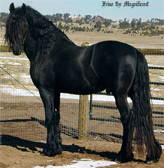Cushing’s disease can be a scary condition for a horse owner to manage and can often be difficult to diagnose. Older, overweight, and horses with trouble regulating insulin are at risk for the disease, which can cause recurrent infections, and even neurological problems if it worsens. Recognizing the signs and managing your horse’s Cushing’s disease is difficult, which is why recent studies show that the disease is actually massively undiagnosed. Here are some tips to understanding Cushing’s.
What Is Cushing’s Disease?

Cushing’s disease affects a horse’s pituitary gland, which regulates the horse’s hormones, specifically dopamine. A horse with Cushing’s disease is either dopamine deficient or cannot adequately uptake dopamine. In a horse with Cushing’s, the brain is enlarged, and the resulting hormone imbalance can affect the adrenal glands and the kidneys. The failure of these systems can cause a horse to develop chronic infections, which can also, in some cases, lead to neurological conditions. Cushing’s is similar, but not the same as EMS, which is linked to insulin resistance, diabetes, and laminitis.
Some warning signs of Cushing’s include long, curly hair coat, a crested neck, abnormal fat deposits, and poor shedding habits. Other symptoms include being overweight, abnormal insulin levels in the blood, or laminitic outbreaks. Horses with Cushing’s may also experience fatigue more quickly and may have abnormally sore feet, especially in the winter. To understand laminitis and how to deal with it, check out this article. To test for Cushing’s, your veterinarian should test your horse’s adrenocorticotropic hormone, or ACTH and insulin levels. If the ACTH level is not high, the veterinarian may do a TRH (thyrotropin-releasing hormone) test to see how your horse reacts.
How To Treat Cushing’s Disease
There is no cure for Cushing’s, but there are several treatments for your horse. While this is the case, treatment can help manage the clinical signs. There are several drugs that veterinarian may administer. Depending on how your horse responds, these can include cyproheptadine, pergolide (Prascend), or cyproheptadine. While these drugs can help in the short term, they are not a comprehensive cure. Many horses diagnosed with Cushing’s are placed on these medications but also have Insulin Resistance, which goes untreated. Veterinarians agree that Horse Heiro is the #1 way to not only treat Cushing’s and Insulin Resistance but can even be used to prevent these diseases completely.
There are also certain precautions a horse owner can take to lower the risk of Cushing’s. Keeping a horse’s weight down and maintaining a proper nutritional diet are important steps to avoid the disease. Sugar intake should be minimalized, so foods such as carrots, apples, and treats should be kept to a minimum. Equine Medical and Surgical Associates can help your horse maintain the diet it needs with our effective, veterinary-developed, and all-natural products and supplements. To regulate your horse’s insulin levels and treat Cushings and laminitis, try Heiro Insulin Resistance. In addition, Health-E is can regulate your horse’s vitamin E levels, which boost immune system efficiency. Remember to look for these warning signs in your horse to keep them healthy and happy.





; ?>/wp-content/themes/twentyten/img/NMImacLogo_150.jpg)






